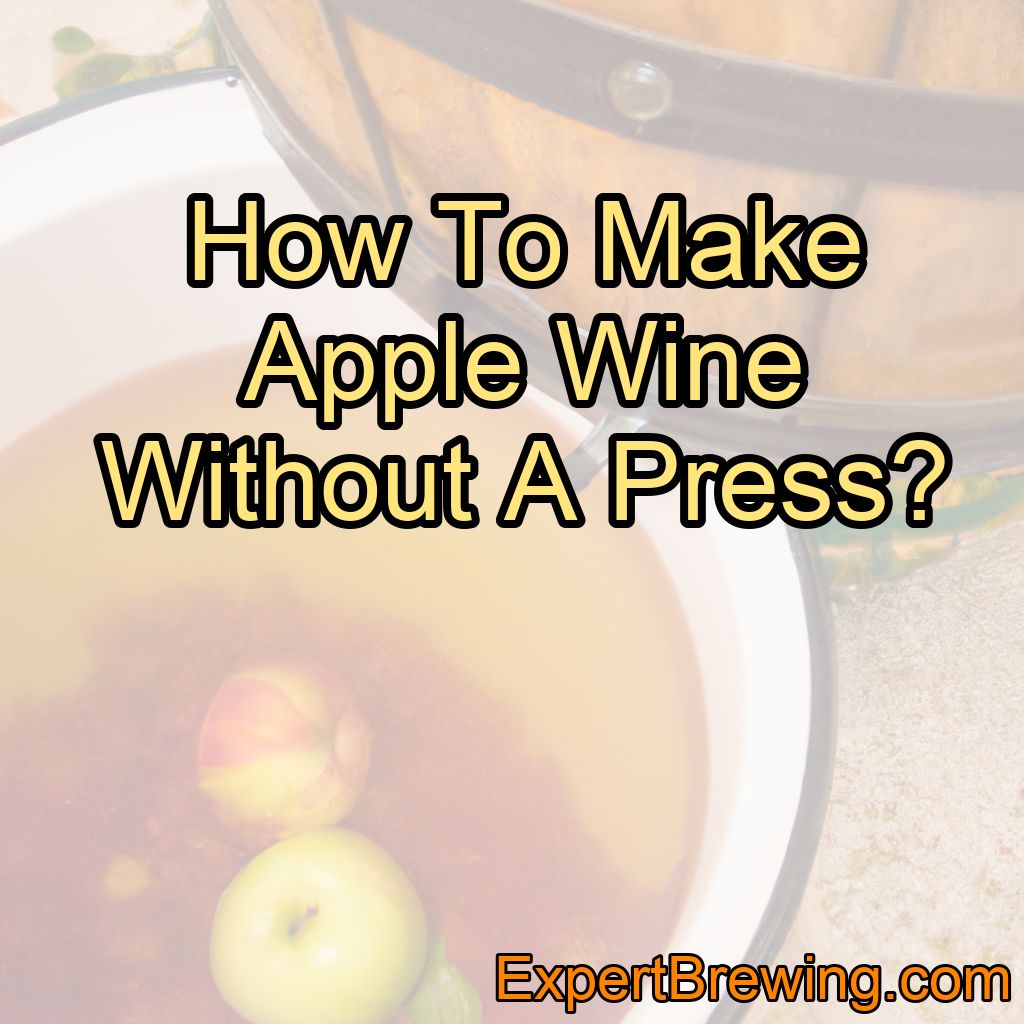Apple wine, also known as hard apple cider, is a delicious and refreshing beverage that’s perfect for sipping during crisp autumn evenings or warm summer days. While many people assume that making apple wine requires a large press to extract the juice from the apples, it’s actually possible to create this tasty beverage without one. In this blog post, I’ll share my personal experience and tips on how to make apple wine without a press, broken down into nine easy-to-follow subheadings.
The simple answer to making apple wine without a press is to chop the apples and then blend or mash them to release their juice. After that, you can ferment the juice with sugar, water, and yeast, followed by several weeks of aging and clarification before bottling the wine.
1. Choosing the Right Apples
The first step in making apple wine without a press is choosing the right apples. While any variety will work, some apples are better suited for winemaking than others. The best apples for making wine are those with a balance of sweetness, acidity, and tannins.
In my experience, some of the best apple varieties for making wine include:
- Gravenstein
- McIntosh
- Winesap
- Braeburn
- Northern Spy
When choosing apples, make sure they are ripe and free of any bruising or blemishes. You can also use a mix of apple varieties to create a more complex flavor profile in your apple wine.
2. Preparing the Apples
Once you’ve selected your apples, it’s time to prepare them for juicing. Wash the apples thoroughly to remove any dirt or residue. Then, use a sharp knife to core the apples and remove any seeds or stems. You can also peel the apples if you prefer, but leaving the skins on will add more tannins and flavor to the wine.
Next, chop the apples into small, even-sized pieces. This will make it easier to extract the juice without a press.
3. Extracting the Juice
To extract the juice from your chopped apples, you can use one of several methods:
–Blending: Place the chopped apples in a blender and blend until they are pureed. You may need to add a small amount of water to help the blender process the apples more efficiently.
–Mashing: Use a potato masher or a large wooden spoon to mash the chopped apples in a large bowl or bucket. This method is more labor-intensive but requires no additional equipment.
–Freezing and Thawing: Place the chopped apples in a plastic bag and freeze them overnight. Then, thaw the apples in a large bowl or bucket. This process will help break down the cell walls, making it easier to extract the juice.
After you’ve extracted the juice, strain it through a fine-mesh strainer or cheesecloth to remove any pulp or solids. This will leave you with a clear apple juice that’s ready for fermentation.
4. Preparing the Fermentation Vessel
Before you begin fermenting your apple juice, you’ll need to prepare your fermentation vessel. This can be a glass or plastic carboy, a food-grade plastic bucket, or a large glass jar. Make sure your fermentation vessel is clean and sanitized to prevent any unwanted bacteria or wild yeast from contaminating your apple wine.
5. Adding Sugar and Yeast
To create alcohol, the yeast needs sugar to ferment. Apples contain natural sugars, but adding additional sugar will help increase the alcohol content of your apple wine. You can use table sugar, brown sugar, or honey, depending on your personal preference.
To determine the amount of sugar needed, use a hydrometer to measure the specific gravity of your apple juice. This will tell you the potential alcohol content of your wine. Most apple wines have a starting specific gravity of 1.060 to 1.090, which will result in an alcohol content of around 8-12%.
Once you’ve determined the amount of sugar needed, dissolve it in a small amount of warm water and then add it to your fermentation vessel along with the apple juice. Next, add the yeast. You can use a wine yeast or a champagne yeast, both of which are readily available at homebrew supply stores or online.
6. Fermentation
With your apple juice, sugar, and yeast combined in your fermentation vessel, it’s time to let the fermentation process begin. Seal your fermentation vessel with an airlock to prevent any air or contaminants from entering while allowing carbon dioxide to escape.
Fermentation usually takes about one week, but it can vary depending on factors such as the temperature and the specific yeast strain used. You’ll know fermentation is complete when the bubbling in the airlock slows down or stops completely.
7. Racking and Secondary Fermentation
Once primary fermentation is complete, it’s time to rack your apple wine into a new, clean, and sanitized fermentation vessel. Racking is the process of siphoning the wine off the sediment that has collected at the bottom of the fermentation vessel. This helps to clarify the wine and prevent off-flavors from developing.
After racking, seal your new fermentation vessel with an airlock and allow the apple wine to undergo secondary fermentation. This process can take several weeks to several months, depending on your desired level of clarity and flavor development.
8. Bottling and Aging
When your apple wine has reached your desired level of clarity and flavor, it’s time to bottle it. Siphon the wine into clean and sanitized bottles, leaving a small amount of headspace at the top. Seal the bottles with corks or caps, depending on your preference.
Age your apple wine for at least three months before tasting. The flavors will continue to develop and improve over time, so it’s worth waiting to enjoy the fruits of your labor.
9. Enjoying Your Homemade Apple Wine
After the aging process is complete, it’s time to enjoy your homemade apple wine! Chill the wine in the refrigerator before serving, and enjoy it on its own or paired with your favorite meal. Homemade apple wine makes a great gift for friends and family, or a delicious treat to enjoy yourself.
In conclusion, making apple wine without a press is a simple and rewarding process. By following these steps, you can create a delicious beverage that’s perfect for enjoying year-round. To recap, here are ten key facts about making apple wine without a press:
1. Choose the right apples for a balanced flavor.
2. Prepare the apples by washing, coring, and chopping them.
3. Extract the juice using blending, mashing, or freezing and thawing.
4. Use a clean and sanitized fermentation vessel.
5. Add sugar and yeast for fermentation.
6. Allow the apple wine to ferment for about one week.
7. Rack the wine and allow it to undergo secondary fermentation.
8. Bottle and age the apple wine for at least three months.
9. Enjoy your homemade apple wine chilled and paired with your favorite meal.
10. Share your apple wine with friends and family as a delicious gift or treat.
FAQs
How do you press apples at home?
To press apples at home, you will need an apple press, which can be purchased or rented. First, wash and cut the apples into small pieces. Then, place the apple pieces into the press and turn the handle to crush the apples and extract the juice. Collect the juice in a container and use a strainer to remove any pulp or debris. The juice can be used for making cider or other apple-based beverages.
What do you need to press apples?
To press apples, you need an apple press or cider press, which typically consists of a large barrel or basket to hold the apples, a pressing plate or mechanism to apply pressure, and a collection container for the juice.
How to make wine from apples at home?
To make wine from apples at home, you will need to first press the apples to extract the juice. Then, add yeast to the juice and allow it to ferment for several weeks. Once the fermentation is complete, transfer the wine to a secondary vessel and allow it to age for several months before bottling. It is important to maintain a sterile environment throughout the process to prevent contamination and spoilage.
How many pounds of apples does it take to make 5 gallons of wine?
It typically takes around 40-50 pounds of apples to make 5 gallons of apple wine.
How many apples does it take to make 5 gallons?
It depends on the size and type of apples, as well as the method of extraction, so there is no definitive answer.
How do you press apples without a press?
One option is to use a blender or food processor to puree the apples, then strain the mixture through a cheesecloth or fine mesh strainer to separate the juice from the pulp. Another option is to place the apples in a clean pillowcase or cloth and squeeze the juice out by hand or with a rolling pin.




